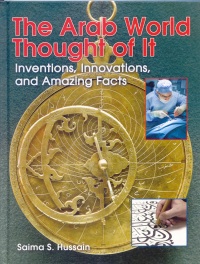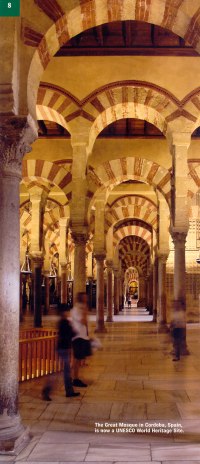| ________________
CM . . .
. Volume XIX Number 41. . . .June 21, 2013
This fascinating, informative book is the sixth in the series, preceded by books about the innovations and cultures of the Inuit, Native Americans, Chinese, Africans and Latin Americans. Humans all over the world have been creative and innovative throughout time. The Arabs have also made their own unique contributions to the world of today. Author Saima S. Hussain brings to the book her personal experiences as a child growing up in the Kingdom of Saudi Arabia. Her memories of shopping with her mother at the outdoor market, or souk, contrast with her descriptions of life on the Arabian Peninsula today. From Bedouin desert nomads to the enormously oil-rich sheiks, Arabs are as different as they are the same. The spread of the Muslim culture and religion around the world has not only expanded our understanding of them but also has enmeshed their innovations and creations into our own. Some famous people who can trace their roots to an Arab country are singer Shakira and actresses Salma Hayek and Paula Abdul. Innovations in the fields of places of learning, astronomy and flight, medicine, arts and crafts and weapons and war are explained. Did you know the Arabs had the first libraries that allowed take out privileges? The caliph al-Mamum was very interested in helping scholars and not only had universities built, but planetariums and observatories as well. In medicine, cataract surgery, the modern scalpel and curved surgical needle for making stitches originated in an Arab country. The Arabs have been famous for their beautiful calligraphy, pottery, stained glass windows and especially their style of decoration called arabesque. “Arabesque is elaborate geometric designs filled with many tiny details. Foods we eat that were created by Arabs include tabbouleh, hummus, pita, sherbet and halwa, to name a few. Other everyday inventions include tents made from carpets, an automatic clock, bar soap, perfume, a pinhole camera and cotton and wool mattresses. Even the shapes of our numbers come from the Arab style. Arab architecture and Muslim religion and cultural holidays are also explained. Perhaps the most interesting feature in this book is the inclusion of a page describing the contributions of Arab women. They have provided water to those on their journey to Mecca, and have created schools and women's shelters. Foods we eat that were created by Arabs include tabbouleh, hummus, pita, sherbet and halwa, to name a few. Other everyday inventions include tents made from carpets, an automatic clock, bar soap, perfume, a pinhole camera and cotton and wool mattresses. Even the shapes of our numbers come from the Arab style. Arab architecture and Muslim religion and cultural holidays are also explained. Perhaps the most interesting feature in this book is the inclusion of a page describing the contributions of Arab women. They have provided water to those on their journey to Mecca, and have created schools and women's shelters. Beautiful photographs of the people, architecture and art adorn the pages. Pictures of the desert and the cities provide a background to smaller, captioned pictures. Arabesque and calligraphy are splashed everywhere. Anyone reading The Arab World Thought of is sure to develop a greater appreciation for the Arab culture that has its roots in the desert.
Highly Recommended. Sherry Faller is a retired teacher-librarian in Winnipeg, MB.
To comment
on this title or this review, send mail to cm@umanitoba.ca.
Copyright © the Manitoba Library Association. Reproduction for personal
use is permitted only if this copyright notice is maintained. Any
other reproduction is prohibited without permission.
NEXT REVIEW |
TABLE OF CONTENTS FOR THIS ISSUE
- June 21, 2013.
AUTHORS |
TITLES |
MEDIA REVIEWS |
PROFILES |
BACK ISSUES |
SEARCH |
CMARCHIVE |
HOME |

 The book begins with a Contents page and a personalized introduction by the author. A map of today's Arab world and an ancient map and timeline are quite an interesting study. As far back as 900 BCE, there were many Arabian kingdoms and tribes. Over the centuries, these have morphed into caliphates (ruling families) to multicultural empires, to independent Arab countries.
The book begins with a Contents page and a personalized introduction by the author. A map of today's Arab world and an ancient map and timeline are quite an interesting study. As far back as 900 BCE, there were many Arabian kingdoms and tribes. Over the centuries, these have morphed into caliphates (ruling families) to multicultural empires, to independent Arab countries.